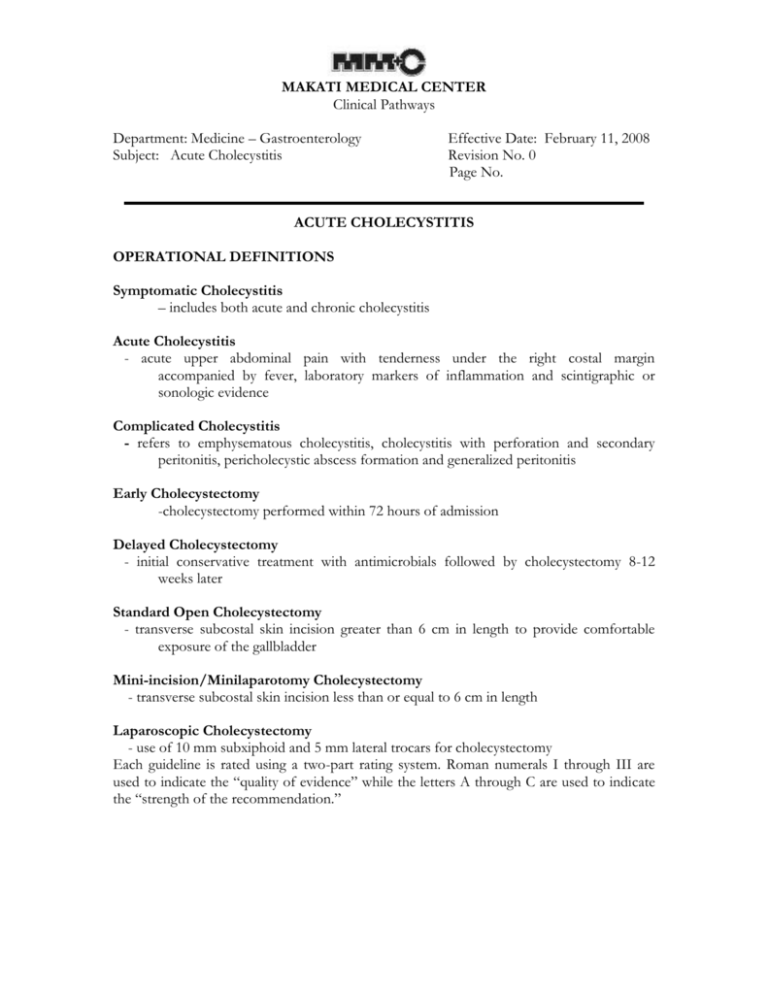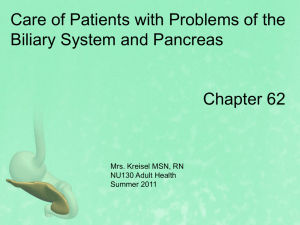ALLERGIC RHINITIS - medicine department
advertisement

MAKATI MEDICAL CENTER Clinical Pathways Department: Medicine – Gastroenterology Subject: Acute Cholecystitis Effective Date: February 11, 2008 Revision No. 0 Page No. ACUTE CHOLECYSTITIS OPERATIONAL DEFINITIONS Symptomatic Cholecystitis – includes both acute and chronic cholecystitis Acute Cholecystitis - acute upper abdominal pain with tenderness under the right costal margin accompanied by fever, laboratory markers of inflammation and scintigraphic or sonologic evidence Complicated Cholecystitis - refers to emphysematous cholecystitis, cholecystitis with perforation and secondary peritonitis, pericholecystic abscess formation and generalized peritonitis Early Cholecystectomy -cholecystectomy performed within 72 hours of admission Delayed Cholecystectomy - initial conservative treatment with antimicrobials followed by cholecystectomy 8-12 weeks later Standard Open Cholecystectomy - transverse subcostal skin incision greater than 6 cm in length to provide comfortable exposure of the gallbladder Mini-incision/Minilaparotomy Cholecystectomy - transverse subcostal skin incision less than or equal to 6 cm in length Laparoscopic Cholecystectomy - use of 10 mm subxiphoid and 5 mm lateral trocars for cholecystectomy Each guideline is rated using a two-part rating system. Roman numerals I through III are used to indicate the “quality of evidence” while the letters A through C are used to indicate the “strength of the recommendation.” MAKATI MEDICAL CENTER Clinical Pathways Department: Medicine – Gastroenterology Subject: Acute Cholecystitis Effective Date: February 11, 2008 Revision No. 0 Page No. PRACTICE GUIDELINES The clinical evidence was rated according to the assessment system of the Infectious Disease Society of America: Level I – Evidence from at least one properly designed randomized controlled trial or meta-analysis Level II – Evidence from at least one well-designed clinical trial without proper randomization, from cohort or case-controlled analytic studies (preferably from one center), from multiple time-series, or from dramatic results in uncontrolled experiments Level III – Evidence from opinions of respected authorities on the basis of clinical The strength of recommendations for the guidelines was categorized according to the level of agreement of the panel of experts after a votation of the participants: Category A – Recommendations that were approved by consensus (at least 75 per cent of the multi-sectoral expert panel) Category B – Recommendations that were somewhat controversial and did not meet consensus Category C – Recommendations that caused real disagreements among the members of the panel DIAGNOSIS No single clinical finding or combination of findings is sufficient to establish or exclude the diagnosis of symptomatic cholecystitis. (LEVEL I EVIDENCE, CATEGORY A RECOMMENDATION) The most accurate imaging test in suspected acute cholecystitis is hepatobiliary scintigraphy. (LEVEL I EVIDENCE) For practical purposes however, ultrasonography is the appropriate initial imaging procedure. (LEVEL III EVIDENCE, CATEGORY A RECOMMENDATION) Ultrasound is the most helpful diagnostic test for chronic calculous cholecystitis. MAKATI MEDICAL CENTER Clinical Pathways Department: Medicine – Gastroenterology Subject: Acute Cholecystitis Effective Date: February 11, 2008 Revision No. 0 Page No. TREATMENT Routine cholecystectomy is not recommended for asymptomatic gallstones. (LEVEL II EVIDENCE, CATEGORY A RECOMMENDATION). However, cholecystectomy may be considered in a selected group of patients. (LEVEL III EVIDENCE, CATEGORY A RECOMMENDATION A. ACUTE CHOLECYSTITIS The recommended surgical approaches for acute cholecystitis are open cholecystectomy (standard or mini-cholecystectomy) or laparoscopic cholecystectomy. (LEVEL I EVIDENCE, CATEGORY A RECOMMENDATION) Patients with acute cholecystitis should undergo cholecystectomy within 72 hours of admission. (LEVEL I EVIDENCE, CATEGORY A RECOMMENDATION) Empiric antibiotic therapy is recommended for patients with acute cholecystitis. (LEVEL I EVIDENCE, CATEGORY A RECOMMENDATION) The following antibiotics are recommended for therapy in uncomplicated acute cholecystitis: Cefazolin 1 gram IV every 8 hours Cefuroxime 1.5 grams IV every 8 hours Cefoxitin 2 grams IV every 8 hours (if at risk for anaerobic infection) For patients with allergy to beta-lactam antibiotics: Fluoroquinolone 400 mg IV every 12 hours +/- Metronidazole 500 mg IV every 6 hours LEVEL I EVIDENCE CATEGORY A RECOMMENDATION The following antibiotics are recommended for therapy in complicated acute cholecystitis: Cefoxitin 2 grams IV every 8 hours Ertapenem 1 gram IV every 24 hours Beta-lactam/Beta-lactamase inhibitors: Ampicillin-sulbactam 1.5-3 grams IV every 6 hours (add Gentamicin 240 mg IV once a day if with risk for enterococcal infection) For patients with allergy to beta-lactam antibiotics: Fluoroquinolone 400 mg IV every 12 hours plus Metronidazole 500 mg IV every 6 hours LEVEL I EVIDENCE CATEGORY A RECOMMENDATION MAKATI MEDICAL CENTER Clinical Pathways Department: Medicine – Gastroenterology Subject: Acute Cholecystitis The duration of therapy may vary depending operation. Therapy may be maintained for Sequential therapy to oral antibiotics may function has returned. (LEVEL I RECOMMENDATION). Effective Date: February 11, 2008 Revision No. 0 Page No. on the clinician’s assessment after the 5 to 7 days for complicated cases. be considered when gastrointestinal EVIDENCE, CATEGORY A The absence of fever for 24 hours ( temperature < 38 C), the ability to tolerate oral intake and a normal WBC count with 3 per cent or less band forms are useful parameters for the discontinuation of antibiotic therapy. (LEVEL II EVIDENCE, CATEGORY A RECOMMENDATION) B. CHRONIC CHOLECYSTITIS Laparoscopic cholecystectomy is the recommended surgical approach in the management of chronic cholecystitis. (LEVEL I EVIDENCE, CATEGORY A RECOMMENDATION) Open cholecystectomy may be done on an individual basis. (LEVEL III EVIDENCE, CATEGORY A RECOMMENDATION) Antibiotic prophylaxis is recommended for patients who will undergo open cholecystectomy for chronic cholecystitis. (LEVEL I EVIDENCE, CATEGORY A RECOMMENDATION) For patients who will undergo laparoscopic cholecystectomy, antibiotic prophylaxis is likewise recommended. (LEVEL III EVIDENCE, CATEGORY A RECOMMENDATION) The following antibiotics are recommended for prophylaxis in chronic cholecystitis: Cefazolin 1 gram IV single dose within 2 hours pre-operatively Alternative agents: Cefuroxime 1.5 grams IV single dose within 2 hours pre-operatively Gentamicin 80 mg IV single dose within 2 hours pre-operatively LEVEL I EVIDENCE CATEGORY A RECOMMENDATION An intra-peritoneal drain need not be routinely placed after cholecystectomy. (LEVEL I EVIDENCE, CATEGORY A RECOMMENDATION) REFERENCES 1. Alponat A, Cubukcu A, Gonullu N, Canturk Z, Ozbay O. Is minisite cholecystectomy less traumatic? Prospective randomized study comparing minisite and MAKATI MEDICAL CENTER Clinical Pathways Department: Medicine – Gastroenterology Subject: Acute Cholecystitis conventional laparoscopic Dec;26(12):1437-1440. 2. Effective Date: February 11, 2008 Revision No. 0 Page No. cholecystectomies. World J Surg. 2002 Assalia A, Kopelman D, and Hashmonai M. Emergency minilaparotomy cholecystectomy for acute cholecystitis: prospective randomized trial-implications for the laparoscopic era. World J Surg 1997; 21:534-539. 3. Barie PS, Vogel SB, Dellinger P, et al. Randomized, double-blind clinical trial comparing cefepime plus metronidazole with imipenem-cilastatin in the treatment of complicated intra-abdominal infections. Arch Surg 1997; 132: 1294-1302. 4. Berggren U, Gordh T, Grama D et al. Laparoscopic versus open cholecystectomy: hospitalization, sick leave, analgesia and trauma responses. Br J Surg 1994; 81: 1362-1365. 5. Berne TV, Yellin AE, Appleman MD, Gill MA, Chenella FC, Heseltine PNR. Controlled comparison of cefmetazole with cefoxitin for prophylaxis in elective cholecystectomy. Surg Gynecol Obstetr 1990; 170: 137-140. 6. Bourgalt AM, England DM, Rosenblatt JE, et al. Clinical characteristics on anaerobic bactobilia. Arch Intern Med 1979; 139: 1346-1349. 7. Burnett RJ, Haverstock DC, Dellinger EP, et al. Definition of the role of enterococcus in intraabdominal infection: Analysis of a prospective randomized trial. Surgery 1995; 118: 716-23. 8. Christou NV, Turgeon P, Wassef R. Management of intra-abdominal infections: The case for intraoperative cultures and comprehensive broad-spectrum antibiotic coverage. Arch Surg 1996; 131: 1193-1201. 9. Cohn SM, Lipsett PA, Buchman TG, et al. Comparison of intravenous/oral ciprofloxacin plus metronidazole versus piperacillin/tazobactam in the treatment of complicated intraabdominal infections. Ann Surg 2000; 232 (2): 254-262. 10. Dougherty SH, Saltzstein EC, Peacock JB, Mercer LC. Cefamandole versus cefoxitin prophylaxis in patients undergoing cholecystectomy. Am Surg 1988; 54: 495-499. 11. Edmiston Jr CE, Suarez EC, Walker AP, et al. Penetration of ciprofloxacin and fleroxacin into biliary tract. Antimicrob Agents Chemother 1996; 40: 787-788. MAKATI MEDICAL CENTER Clinical Pathways Department: Medicine – Gastroenterology Subject: Acute Cholecystitis Effective Date: February 11, 2008 Revision No. 0 Page No. 12. Eldar S, Sabo E, Nash E, et al. Laparoscopic cholecystectomy for acute cholecystitis: prospective trial. World J Surg 1997; 21: 540-545.








